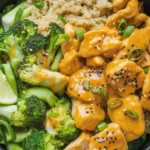
Let’s face it: not every workplace has a fully equipped kitchen. Some offices lack microwaves due to space constraints, safety policies, or just outdated facilities. And if you’re working from a co-working space or a client site, you might be stuck with whatever you brought. Even at home, you might want to avoid the hassle of reheating to save time. No-microwave lunches are a game-changer because they’re portable, versatile, and designed to taste great at room temperature. Plus, they save you from the office microwave line, where you’re stuck behind someone heating fish (we’ve all been there). According to Harvard Health, meal prepping can also help you control portions and make healthier choices, which is a win when you’re trying to stay energized through the afternoon slump.
But it’s not just about convenience. No-microwave meals force you to think creatively, leading to lunches that are often fresher, more vibrant, and packed with flavor. From hearty salads to clever wraps, these meals can be just as satisfying as their heated counterparts. In this post, we’ll explore a variety of recipes, prep tips, and strategies to make your work lunches something to look forward to—no microwave required.
Read Also: Healthy Lunch Ideas: Delicious, Nutritious Meals to Fuel Your Day
The Art of Planning No-Microwave Lunches
Before diving into specific recipes, let’s talk strategy. Planning is the backbone of great no-microwave lunches. Without it, you’re likely to fall back on the same old sandwich or overpriced takeout. A little forethought can transform your lunch game. Here’s how to set yourself up for success, inspired by my own trial-and-error days of packing lunches for a hectic workweek.
Start with a Weekly Meal Plan
Planning your lunches for the week saves time and reduces decision fatigue. Every Sunday, I sit down with a cup of coffee and sketch out five lunch ideas. This doesn’t mean you need to cook every day—batch prepping is your friend. Choose recipes that share ingredients to cut costs and waste. For example, if you’re making a quinoa salad, save some quinoa for a wrap later in the week. The USDA’s MyPlate offers great guidelines for balancing protein, veggies, and grains, ensuring your lunches are nutritious and filling.
- Pick a theme: Themes like “Mediterranean Monday” or “Taco Tuesday” make planning fun and varied.
- Shop smart: Buy versatile ingredients like canned beans, rotisserie chicken, or pre-washed greens to save time.
- Prep in batches: Cook grains or chop veggies for multiple meals at once to streamline your week.
Invest in the Right Gear
The right containers can make or break your no-microwave lunch. I learned this the hard way when a leaky container turned my bag into a salad swamp. Invest in high-quality, leak-proof containers like those from Yeti or Bentgo. Bento-style boxes with compartments are perfect for keeping ingredients separate until you’re ready to eat. A small insulated lunch bag with an ice pack keeps food fresh, especially for dairy or meat-based dishes. The FDA recommends keeping perishable foods below 40°F to prevent spoilage, so don’t skip the ice pack if your lunch will sit out for a few hours.
Focus on Room-Temperature-Friendly Ingredients
Not all foods taste good cold, but many do. Think about ingredients that hold up well without reheating: hearty grains like quinoa or farro, canned beans, cured meats, hard cheeses, and sturdy veggies like cherry tomatoes or bell peppers. Avoid ingredients that get soggy, like delicate lettuces, unless you pack them separately. A tip I picked up from a Bon Appétit article is to layer ingredients strategically—put dressings at the bottom of a jar to keep salads crisp until you shake them up.
No-Microwave Lunch Ideas to Keep You Inspired
Now, let’s get to the good stuff: the recipes. These lunch ideas are designed to be easy to prep, delicious at room temperature, and varied enough to keep your taste buds happy. I’ve included a mix of salads, wraps, bowls, and snacks, with tips to customize each for different diets or preferences.
1. Mediterranean Chickpea Salad
This salad is my go-to when I need something quick but satisfying. It’s packed with protein, fiber, and bright flavors that don’t fade at room temp. Inspired by a recipe from The Mediterranean Dish, this version is endlessly customizable.
Ingredients (Serves 2):
- 1 can (15 oz) chickpeas, rinsed and drained
- 1 cup cherry tomatoes, halved
- 1 cucumber, diced
- 1/4 cup red onion, finely chopped
- 1/2 cup crumbled feta cheese
- 1/4 cup chopped parsley
- 2 tbsp olive oil
- 1 tbsp lemon juice
- 1 tsp dried oregano
- Salt and pepper to taste
Instructions:
- In a large bowl, toss chickpeas, tomatoes, cucumber, onion, feta, and parsley.
- In a small jar, mix olive oil, lemon juice, oregano, salt, and pepper to make the dressing.
- Pour dressing over the salad and toss. Divide into two containers for easy packing.
- Optional: Add cooked quinoa or olives for extra flavor.
Why It Works: Chickpeas are filling and hold their texture well, while feta adds a salty kick that doesn’t need reheating. Pack the dressing separately if you’re prepping ahead to keep veggies crisp.
2. Chicken Caesar Wrap
Wraps are a lunchtime MVP—they’re portable, customizable, and don’t require a fork. This Caesar wrap, inspired by a recipe from EatingWell, uses rotisserie chicken to save time.
Ingredients (Serves 1):
- 1 large whole-grain tortilla
- 1 cup shredded rotisserie chicken
- 2 cups chopped romaine lettuce
- 2 tbsp Caesar dressing (store-bought or homemade)
- 1/4 cup grated Parmesan
- 1/2 cup croutons (optional for crunch)
Instructions:
- Lay the tortilla flat and spread Caesar dressing in the center.
- Layer chicken, romaine, Parmesan, and croutons.
- Fold tightly into a wrap, tucking in the sides. Wrap in foil for easy transport.
- Serve with a side of baby carrots or fruit.
Why It Works: Romaine stays crisp for hours, and the dressing coats the chicken to prevent sogginess. Swap chicken for tofu or chickpeas for a vegetarian version.
3. Sushi-Inspired Rice Bowl
Craving sushi but don’t want to splurge? This rice bowl brings those flavors to your lunchbox without needing a fridge or microwave. I got the idea from a Taste of Home recipe and tweaked it for simplicity.
Ingredients (Serves 1):
- 1 cup cooked sushi rice or brown rice
- 1/2 avocado, sliced
- 1/2 cup shredded carrots
- 1/4 cup cucumber, julienned
- 1/4 cup imitation crab or smoked salmon
- 1 tbsp soy sauce
- 1 tsp sesame seeds
- 1 sheet nori, cut into strips
Instructions:
- Layer rice in a container, then top with avocado, carrots, cucumber, and crab or salmon.
- Sprinkle with sesame seeds and nori strips.
- Pack soy sauce in a small container to drizzle just before eating.
Why It Works: The rice holds up well at room temperature, and the nori adds a sushi-like crunch without needing refrigeration. Use tamari for a gluten-free option.
4. Pesto Pasta Salad
Pasta salads are a classic for a reason—they’re easy to prep in bulk and taste great cold. This version, inspired by Delish, uses pesto for a burst of flavor.
Ingredients (Serves 2):
- 2 cups cooked rotini or farfalle pasta
- 1/2 cup cherry tomatoes, halved
- 1/2 cup mozzarella balls (bocconcini)
- 1/4 cup sliced black olives
- 2 tbsp store-bought pesto
- 1 tbsp olive oil
- Salt and pepper to taste
Instructions:
- Cook pasta according to package instructions, then rinse under cold water to cool.
- In a bowl, mix pasta, tomatoes, mozzarella, and olives.
- Stir in pesto and olive oil, then season with salt and pepper.
- Divide into containers and store in the fridge until ready to pack.
Why It Works: Pesto coats the pasta evenly, preventing it from drying out. The mozzarella balls add a creamy texture that’s perfect at room temp.
5. Snack-Style Lunch Box
Some days, you don’t want a full meal—just a variety of nibbles. This snack-style lunch is perfect for grazing and feels like a treat. I got this idea from a Real Simple article on bento box lunches.
Ingredients (Serves 1):
- 1 hard-boiled egg
- 1 oz cheddar cheese cubes
- 1/2 cup grapes
- 1/4 cup hummus
- 1 cup baby carrots and cucumber slices
- 10 whole-grain crackers
- 2 tbsp mixed nuts
Instructions:
- Arrange ingredients in a bento box or compartmentalized container.
- Pack hummus in a small leak-proof container with a lid.
- Keep the lunch box in an insulated bag with an ice pack.
Why It Works: This mix-and-match approach is fun and satisfying, with a balance of protein, carbs, and fats to keep you full. Swap hummus for guacamole or nut butter for variety.
Comparison Table: No-Microwave Lunch Options at a Glance
Lunch Options Compared: Time, Cost, and Nutrition
| Lunch Idea | Prep Time | Cost per Serving | Key Nutrients | Best For |
|---|---|---|---|---|
| Mediterranean Chickpea Salad | 10 min | ~$2.50 | Protein, fiber, healthy fats | Vegans, vegetarians, meal prep |
| Chicken Caesar Wrap | 5 min | ~$3.00 | Protein, carbs | Quick prep, on-the-go eaters |
| Sushi-Inspired Rice Bowl | 15 min | ~$4.00 | Omega-3s, carbs, fiber | Sushi lovers, adventurous eaters |
| Pesto Pasta Salad | 12 min | ~$3.50 | Carbs, healthy fats | Batch preppers, pasta fans |
| Snack-Style Lunch Box | 5 min | ~$2.80 | Protein, fiber, healthy fats | Grazers, busy schedules |
This table breaks down each option based on prep time, estimated cost (based on average grocery prices), key nutrients, and who it’s best suited for. Use it to pick the lunch that fits your schedule and budget.
Tips for Keeping Lunches Fresh and Safe
Food safety is crucial when you’re packing lunches that won’t be refrigerated or reheated. The CDC notes that bacteria can grow rapidly in the “danger zone” between 40°F and 140°F. Here are some tips to keep your meals safe and tasty:
- Use ice packs: An insulated lunch bag with a reusable ice pack keeps food at a safe temperature. I’ve been using the same Fit & Fresh ice packs for years, and they’re a lifesaver.
- Pack dressings separately: Wet ingredients can make salads or wraps soggy. Use small containers or mason jars to keep dressings and sauces separate.
- Choose shelf-stable proteins: Canned beans, tuna, or cured meats like salami are safe at room temp for a few hours and add protein without needing refrigeration.
- Eat within four hours: If your lunch won’t be refrigerated, aim to eat it within four hours of leaving home to stay in the safe zone.
Customizing for Dietary Needs
No-microwave lunches can work for almost any diet with a few tweaks. Here’s how to adapt the recipes above:
- Vegetarian/Vegan: Swap chicken or fish for tofu, tempeh, or extra beans. Use nutritional yeast or vegan cheese in place of feta or Parmesan.
- Gluten-Free: Use gluten-free wraps, pasta, or rice instead of wheat-based options. Double-check labels on dressings and sauces.
- Low-Carb/Keto: Skip grains and focus on protein-heavy options like the snack box or a salad with avocado and nuts.
- High-Protein: Add extra chicken, eggs, or Greek yogurt-based dips to boost protein content.
I once worked with a colleague who was keto and swore by packing mason jar salads with avocado and bacon—proof you can make any diet work without a microwave.
FAQ: Your No-Microwave Lunch Questions Answered
How do I keep my lunch fresh without a fridge?
Use an insulated lunch bag with an ice pack to keep food below 40°F. Pack ingredients like hard-boiled eggs or canned beans that are safe at room temp for a few hours. Layer wet and dry ingredients separately to avoid sogginess.
Can I prep these lunches the night before?
Absolutely! All the recipes above can be prepped the night before or even a few days in advance. Store in airtight containers in the fridge, and pack with an ice pack in the morning.
What if I don’t like salads or wraps?
Try the snack-style lunch box for a mix-and-match approach, or experiment with grain bowls like the sushi-inspired rice bowl. You can also make cold noodle dishes with sesame oil or peanut sauce.
Are no-microwave lunches cheaper than takeout?
Yes, most of these lunches cost $2–$4 per serving, compared to $10–$15 for takeout. Batch prepping and using pantry staples like beans or rice can save even more.
How do I avoid boring lunches?
Rotate recipes weekly and experiment with global flavors like Mexican, Italian, or Asian-inspired dishes. Add variety with different toppings, like nuts, seeds, or fresh herbs.
Conclusion: Elevate Your Lunch Game
Packing a no-microwave lunch doesn’t have to be a chore—it’s an opportunity to get creative, save money, and eat well. From vibrant chickpea salads to portable wraps and snack boxes, these ideas prove that you don’t need a microwave to enjoy a delicious, satisfying meal at work. By planning ahead, investing in good containers, and choosing ingredients that shine at room temperature, you can transform your lunch break into a highlight of your day. I’ve been packing lunches for years, and the joy of opening a colorful, flavorful meal still beats the monotony of takeout.
So, what’s next? Start small—pick one recipe from this post and try it next week. Experiment with flavors, tweak ingredients to suit your taste, and don’t be afraid to make it your own. If you’re feeling inspired, check out sites like Epicurious for more no-cook recipe ideas, or share your creations with coworkers to spark a lunch-prep revolution. Here’s to lunches that are as exciting as they are easy—no microwave required.









